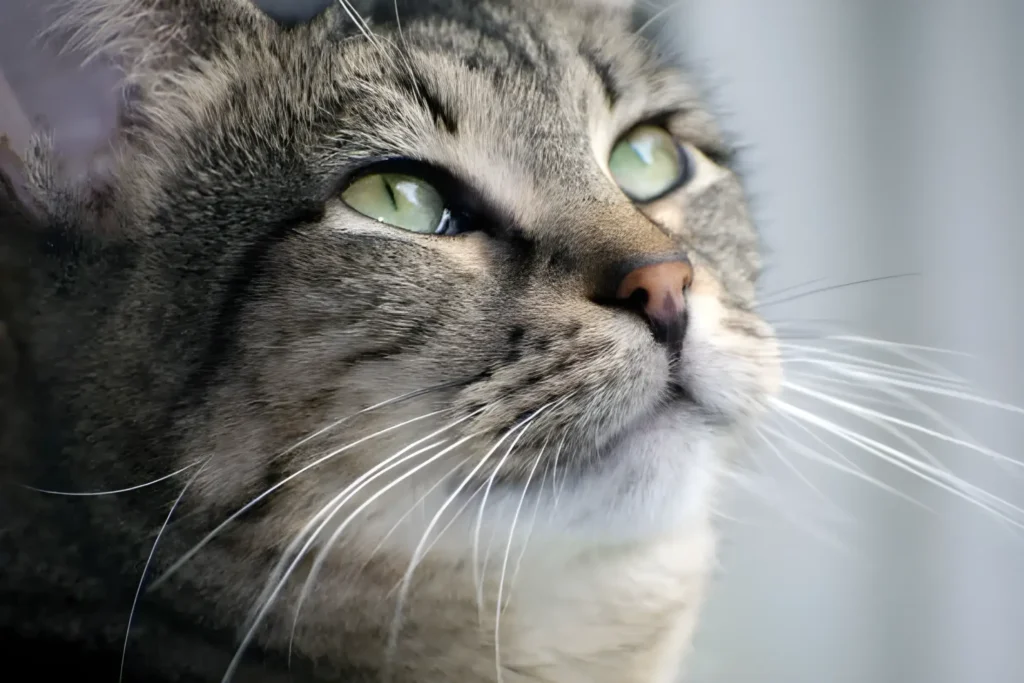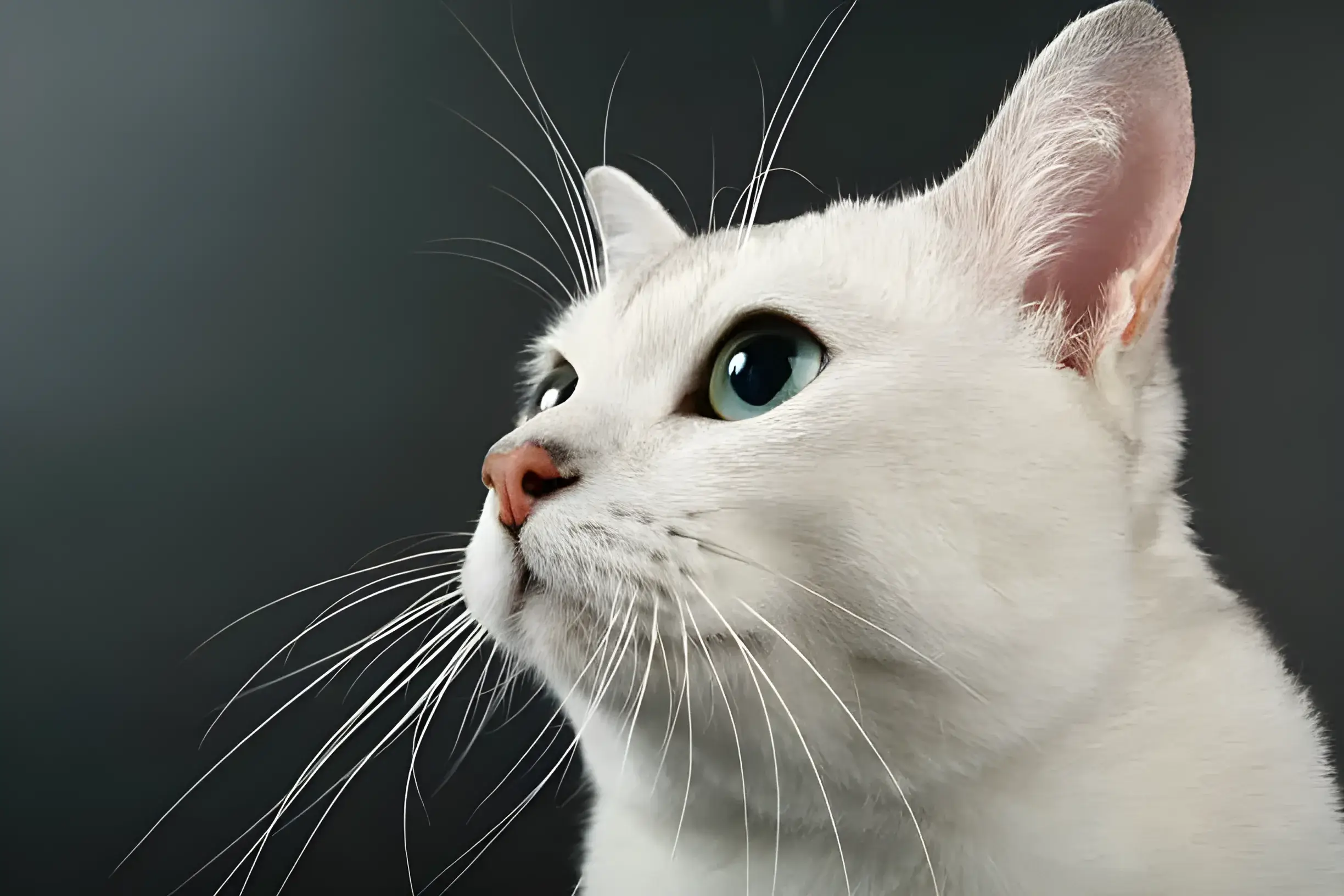If you’ve ever wondered about trimming your cat’s whiskers, the answer is a resounding no. Cat whiskers are specialized sensory tools that help your feline friend navigate the world. Trimming them causes disorientation, potential danger, and unnecessary discomfort.
Whiskers: More Than Just Hair
Cat whiskers, scientifically called vibrissae, are far more complex than ordinary fur. They’re embedded deeply in the skin and surrounded by sensitive nerve endings. These specialized hairs help cats:
Navigate in the dark: Whiskers detect subtle air currents and vibrations, allowing cats to “see” obstacles even with limited light.
Judge distances accurately: Whiskers assist in determining whether a space is wide enough for a cat to pass through, preventing them from getting stuck.
Hunt effectively: Whiskers act almost like radar, helping cats sense the movement of prey.
The Consequences of Trimming
Cutting a cat’s whiskers has several negative consequences:
Disorientation and confusion: Cats without their whiskers may misjudge distances, bump into objects, and become generally unsure of their surroundings.
Increased risk of injury: A disoriented cat is more prone to falls or accidents, especially in unfamiliar environments.
Difficulty hunting: Impaired whisker function may hinder a cat’s ability to catch prey.
Potential discomfort: While the whiskers themselves don’t have feeling, the deep follicles at the base contain nerves. Trimming may cause discomfort or even pain.
Regrowth and Adaptation
Thankfully, cat whiskers do grow back if cut. However, this regrowth process can take several weeks or months. During this time, cats may exhibit clumsiness and have a harder time navigating – particularly in low light.
If matted or tangled whiskers are a concern, consult a veterinarian or professional groomer rather than attempting to trim them yourself.
Whisker Wisdom

Natural shedding is normal: Cats shed whiskers periodically, just like regular hair. Don’t be alarmed if you find a whisker on the floor.
Other whiskered creatures: Many mammals, including rodents, seals, and dogs, rely on whiskers for important sensory information.
Myths about Cat Whiskers
People may innocently misunderstand the role of whiskers and believe trimming is harmless or even beneficial. Here’s why these myths are wrong:
Myth: Whiskers make a cat look scruffy.
- Truth: Whiskers are an essential part of a cat’s natural appearance. Trimming them disrupts their ability to sense their surroundings and can be cruel.
Myth: Trimming prevents shedding.
- Truth: Whiskers don’t contribute to shedding, which is a natural process. Regular brushing helps control loose fur more effectively.
Myth: Indoor cats don’t need whiskers as much.
- Truth: Even indoor cats rely on whiskers to navigate furniture, avoid obstacles, and judge distances when jumping. A safe and enriched indoor environment is still essential for whisker function.
How to Care for Your Cat’s Whiskers
Be respectful: Avoid treating a cat’s whiskers like a toy. Resist the urge to stroke or pull on them, as this can be uncomfortable or disorienting.
Mind your environment: If your cat is older or easily overstimulated, try to create calm, quiet areas in your home where they can rest without their whiskers constantly brushing against things.
Know when to consult a vet: Excessively damaged whiskers, or whiskers that seem consistently broken, could indicate a health concern or an issue in your cat’s environment causing undue stress. A veterinary checkup is wise in such situations.
Real-Life Stories: The Importance of Whiskers in Action
“Luna, a playful indoor cat. One day, her curious nature led her a little too close to the stove. A misplaced trim left her whiskers slightly shorter on one side. Later that evening, Luna attempted her usual jump onto the counter to investigate a tempting treat. Without her full range of sensation, she misjudged the distance and fell, landing with a startled meow. This Real-Life story highlights how even minor whisker disruption can have real consequences for a cat’s ability to navigate safely.” – Amelia Phillips Luna’s owner
Conclusion
Cat whiskers are essential tools, not an aesthetic feature. Respecting these integral sensory organs is a vital part of responsible cat ownership. By understanding their importance and providing proper care, we can help our feline companions navigate the world with confidence and grace.
The photo featured below the post headline is Credit: jehandmade/istockphoto
I hope you find this post helpful and informative. If Yes’ feel free to share it with your friends!
Frequently Asked Question
Does it hurt when a cat’s whiskers are cut?
While the whisker itself doesn’t have feeling, the follicle at the base is rich in nerves. There’s a possibility that cutting may cause discomfort or even pain. Many vets and experts advise against trimming to avoid unnecessary stress for your cat.
Do cat whiskers have nerves?
Yes! The base of each whisker has a follicle surrounded by a network of sensitive nerves. These nerves are what allow whiskers to transmit crucial sensory information to the cat’s brain.
Why would someone cut a cat’s whiskers?
There are a few reasons, though most are based on misinformation:
Aesthetics: Some people might mistakenly think trimming makes the cat look neater.
Misunderstanding: They may not realize the importance of whiskers for a cat’s well-being.
Behavioral issues: In rare cases, a vet may recommend slight trimming if whiskers are constantly irritated by a medical condition.
My child accidentally trimmed my cat’s whiskers! What should I do?
Stay calm: While it’s not ideal, your cat will be okay. Whiskers do grow back.
Observe your cat: Watch for signs your cat may be struggling to get around, like bumping into things or misjudging jumps. Offer extra help and a safe space if needed.
Use this as a teaching moment: Gently explain to your child why cats need their whiskers and how important it is to handle animals with care.
My cat’s whiskers seem broken or bent. Should I be worried?
Consider possible causes: Are there rough surfaces your cat rubs against? Is your cat older (whiskers can become more brittle with age)?
Consult your vet: If damaged whiskers seem like a persistent issue, a vet checkup is the best way to rule out any medical problems causing the breakage.
How do cats use whiskers to judge distances?
Spatial awareness tools: Think of whiskers as extra-sensitive “feeler gauges.” They let your cat know if a space is too narrow to fit through and help them navigate obstacles.
Avoiding accidents: This ability to sense their surroundings prevents cats from bumping into things and becoming trapped in tight spots.
Can cats still hunt without whiskers?
Cats with trimmed whiskers will have significantly more difficulty hunting. Whiskers aid in pinpointing prey in motion, even in low light.
Will my cat’s personality change if their whiskers are cut?
While a trimmed whisker won’t directly alter personality, the resulting stress, confusion, and potential for injury can make your cat seem withdrawn, fearful, or less playful.
Can a cat lose its sense of balance if its whiskers are trimmed?
Whiskers play a role in proprioception – a cat’s awareness of its body in space. Trimming whiskers can contribute to poor balance and clumsiness.
Do indoor cats need their whiskers as much as outdoor cats?
Yes! Whiskers are vital for navigating furniture, judging jumps, and avoiding hazards regardless of the cat’s lifestyle.
How long does it take for cat whiskers to grow back?
Whisker regrowth can take several weeks to months. During this time, your cat may need extra assistance in finding food bowls or navigating familiar spaces.

